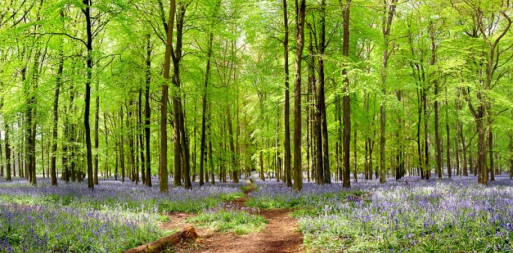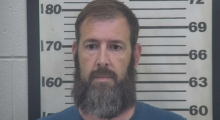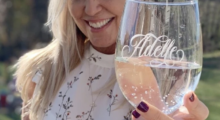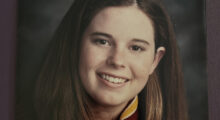In part one of a two-part interview, SevenPonds speaks with the Dublin-born, UK-based photographer David Anthony Hall. David’s work inspires its viewer to reflect upon his or her relationship with the natural world, and his sprawling photographs of woodlands have been recognized worldwide. But amongst his proudest achievements is his work’s relationship to hospice environments and cancer research. Through permanently installing his work in hospice centers (such as Marie Curie Hospice in the West Midlands, UK), he has consequently become a pioneer of sorts in an important mission: to make hospices not just inhabitable but uplifting.
MaryFrances: How did you get started in photography? How would you describe your work?
David: I got involved in photography in school when I was about 12. I started off by printing my dad’s old negatives – well, one of my dads. A lot of my relationship with photography extends from the fact that I was adopted.
There are five kids in my family and four of us are adopted. Dublin, Ireland is a very small place. There was always this suspicion that you might run into someone who could be your relative. What I loved about photography was that I could be a voyeur, hide behind the camera, take pictures and study them afterwards. I could wonder where I fit in. It was a perfect medium for me to explore my environment, consider my origins and express myself.
MaryFrances: So how did a relationship between your photography and hospice environments come about?
David: My relationship with hospices goes back to when I was a young teenager. My friend Margaret was diagnosed with cancer. She fought it bravely for seven years, but eventually succumbed to the disease. I would visit with her at every stage of her journey, which inevitably ended in a hospice.
It was ultimately very sad as Margaret Browne (1955 – 1987 RIP) was so young and full of life. I would visit her in those last months of her life there, and I always had this dread upon entering the building. Architecturally, it was a somber, dreary place — a former religious building hidden away and badly landscaped. I mean, we’re talking about a building dating back to the 1970s in Dublin. There was just nothing appealing about it.
After studying Photography at art school, I went on to have a career in still life photography in London, which I retired from in 2000. I returned to landscape photography again in my thirties, which coincided with finally meeting my biological parents. My work did well in London galleries. But I didn’t just want to make pretty pictures, I wanted to do something that could help others. I guess I considered myself to be very lucky in life, and I wanted to return something that could promote healing and well-being for people. I also wanted to show a depth to my work, so I started specifically selling work and donating the proceeds. In 2009, I created the largest picture of its kind in the UK, which I dedicated to the memory of my biological father, who died in 2007 of cancer, and I split the $13,000 between Cancer Research UK, Macmillan Cancer Care and the cancer wing in Barth’s Hospital. It felt very good at the time and was, I feel, a wonderful way to mark my natural father’s (Antonio Senezio 1934 – 2007 RIP) life and thank him for giving me mine.
MaryFrances: How do you think photography fits into palliative care?
David: Well I think art in itself is healing. Art was always one of my strong points, and I think being able to express yourself or explore your creativity is very cathartic, regardless of ability. Photography speaks to that because you get instant, brilliant results and with the scale I finish my work, it can transform and humanize even very large spaces.
The context of palliative care and photography is also one of a historical document, I think.
MaryFrances: How so?
David: Well it’s something that allows patients to reflect: Art is a window to the mind, the subconscious, allowing us to escape reality conjuring up all sorts of memories which can open a portal to allow the viewer to look over their lives to look over their relationships with loved ones. In the context of hospices, for example, one can make a kind of picture wall that allows someone to bring together all the aspects of that patient’s life.
David’s 3 Tips:
1) Make art! It becomes a keepsake for loved ones — something to pass on.
2) You don’t have to be an “artist” to express yourself creatively.
3) Spend more time in nature!
Mary Frances: Do you think hospices in the UK are supportive of bringing art and creativity into play?
David: A lot of UK hospices have art and craft rooms where people are encouraged to explore their creativity. I believe it as well as art therapy and outreach programs are considered when applying for Art Council funding.
MaryFrances: How did your collaboration with Marie Curie come about?
David: Well, at the time I was still donating money from the sale of my photographs, and as a continuation of that I started to wonder, what if I could do something even more direct with the hospices and the works? I was creating mural-esque photographs, and they fit very well into the otherwise blank hospice settings.
As I’ve mentioned, cancer has played a big part in my life. All my natural father’s family have died from cancer. Indeed, since his death, his remaining siblings have died as a result of the disease. Now, having only known my biological mother (Maura O’Connor 1951 – 2011 RIP) for 5 years, she was diagnosed with cancer. The news came shortly after Antonio had died, and for her at 56 it was devastating. By this stage, I had been working with Lady Cotton, Head of Special Events at Marie Curie, through my donations to an annual event at the Royal Academy in aid of Marie Curie when I heard of the plans for their new hospice, and we talked over possibilities of installing my work there. It was my first collaboration with a hospice in that way, and although I was partly commissioned for the work I produced it stands as my largest single donation and is one of my proudest achievements. HRH Prince Charles officially opened the Hospice in June 2013.
Please come back for part two of our interview next week.

 What Do Trees and Hospice Centers Have in Common? An Interview with David Anthony Hall, Part One
What Do Trees and Hospice Centers Have in Common? An Interview with David Anthony Hall, Part One




 Funeral Home Owner Chris Johnson Spending Halloween in Jail
Funeral Home Owner Chris Johnson Spending Halloween in Jail
 Our Monthly Tip: Toast a Loved One with a Personalized Glass
Our Monthly Tip: Toast a Loved One with a Personalized Glass
 My Cousin’s Death Taught Me the Meaning of Life
My Cousin’s Death Taught Me the Meaning of Life














